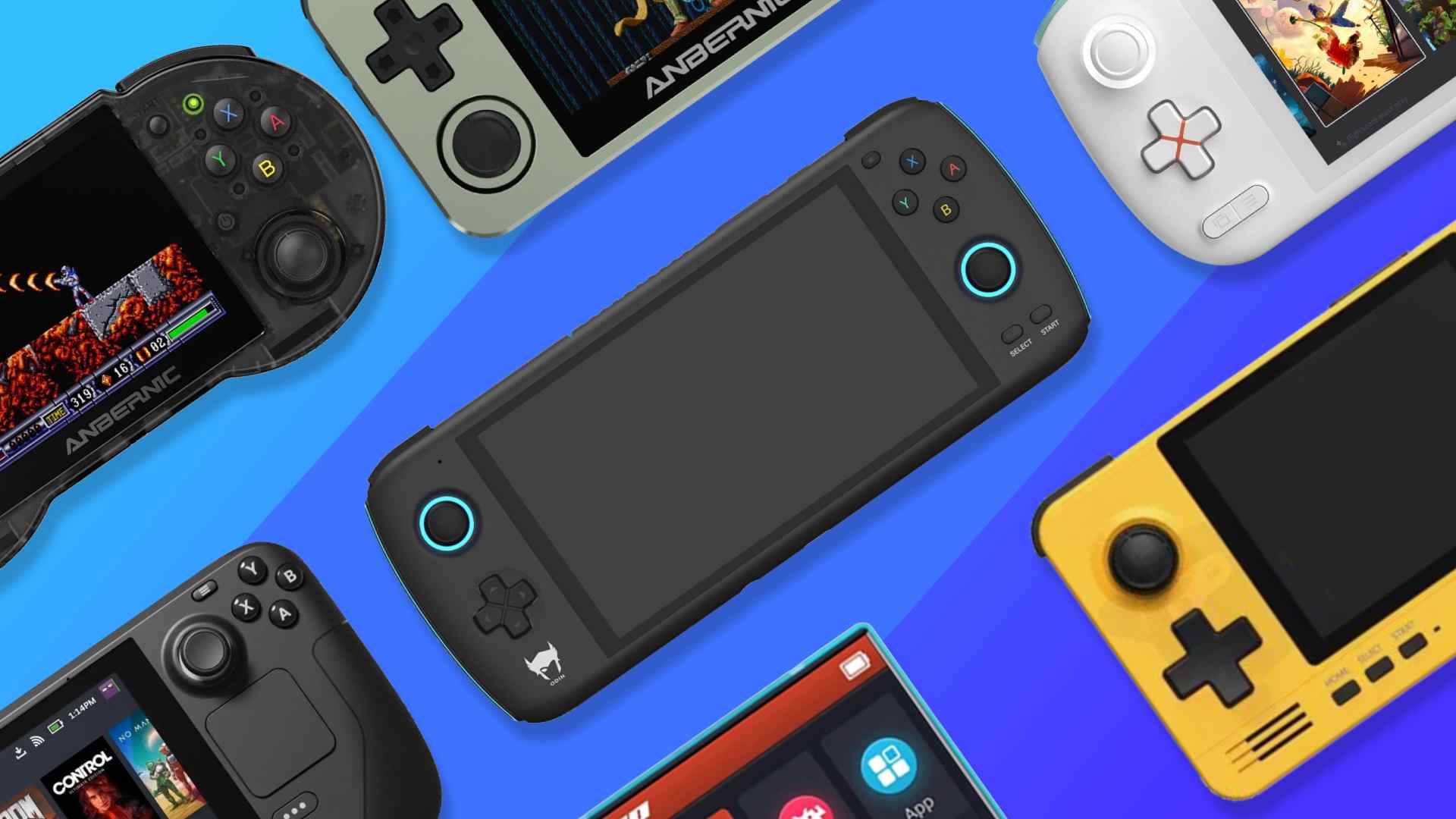Finding the best retro handheld isn’t quite as straightforward as it used to be. More companies than ever are putting out consoles, some good, some amazing, some not so great.
That’s why we’ve put together an in-depth guide to the best handheld emulator consoles out there so you can take the guesswork out of it and find a console that meets both your budget and your emulation needs.
If you’re wondering what I know about handhelds, check out the photo of my many drawers below.
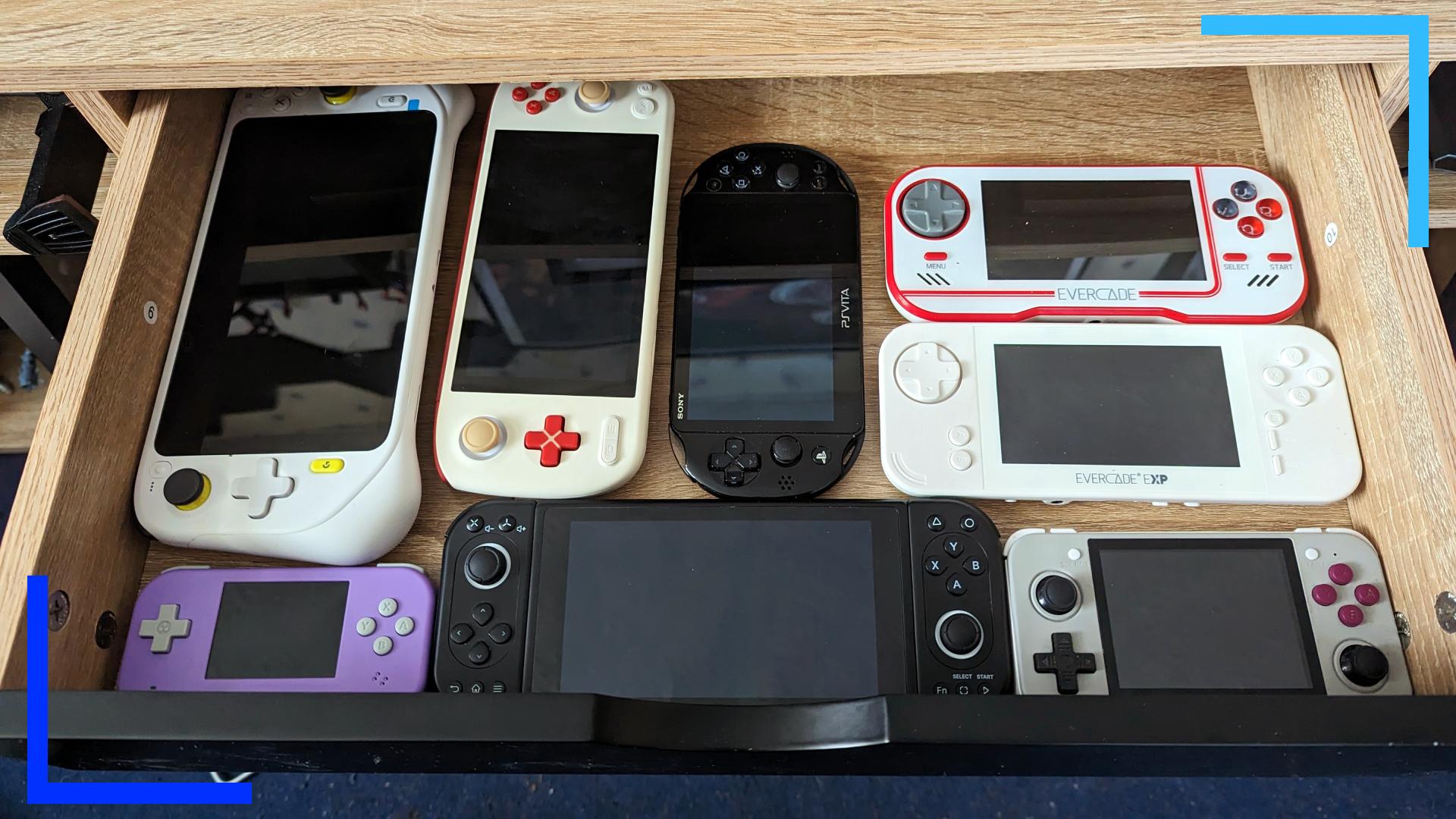
Pictured: From left to right, the Logitech G Cloud, AYANEO Pocket Air, PS Vita, Evercade, Evercade Arcade, TrimUI Smart, Pimax Portal, and an Anbernic RG351.
As you can see, I’ve got a lot of different handhelds. So may say too many, but I’d counter that with “Shut up,” they’re all different and excel at different things. PS2 isn’t going to run on an Anbernic RG351, but that device still rocks when it comes to Game Boy titles. Everything has it’s place, you know?
With that in mind, let’s dive into what I believe are the best options when it comes to emulator handhelds based on my prior experience.
AYANEO Air

The AYANEO Air is the most affordable of the Windows-based handhelds coming in at $549 for the base model.
Y’all know me. Whenever I get a new console the first thing I’m going ot do is see what I can emulate. Unsurprisingly, the AYANEO Air was no different Shocking, I know.
When I first read the specs of the AYANEO Air, my mind instantly started working out what was possible. So when I got it, I had to test it out. I expected, from the specs, that up to PS3, Xbox 360 and Switch would be possible and I wasn’t wrong, but there are a few caveats to that. PS3, Xbox 360, and Nintendo Switch emulation aren’t 100 percent perfect across the board, but what you’ll find is that there are enough of the classics to play to justify it.
I wouldn’t recommend grabbing the AYANEO Air primarily for those systems as not everything will run flawlessly, but if you’re after something that packs a punch and don’t mind fiddling with settings to get the most out of it – I can recommend it.
One of my biggest gripes with handhelds is the screen quality. I like my RG350 handheld but the screen is so dull. Nothing really pops. And when you’re playing games like Street Fighter II, with all the stylish pixel art, not having a nice screen really sucks.
That’s why I was so taken by the AYANEO Air. On top of the emulation options you’ve also got the capacity to play AAA games at a decent resolution. God of War runs in 720p at 30 frames per second; Elden Ring at 720p at around 40 frames per second; and Cyberpunk 2077 at 720p at 30 Frames per second.
Now I know what you’re thinking. 720p? That isn’t 1080p let alone 4K! Here’s what I’ve learned, though: 720p looks awful on a big-screen TV, but when I’m looking at a screen that’s only 5.5 inches wide, it looks a lot more crisp. When the screen pixels are tighter together, everything looks better than it actually is.
AYANEO Air Specs
- CPU: AMD Ryzen 5 5560U Zen 2/AMD Ryzen 7 5826U Zen 3
- GPU: Radeon Vega 7 Graphics/Radeon Vega 8 Graphics
- Storage: Up to 2TB SSD
- Screen: 5.5-inch – 1920 x 1080 OLED
- RAM: 8GB to 32GB DDR4
What Can the AYANEO Air Emulate?
- Sega: Genesis/Mega Drive, Master System, Game Gear, SegaCD, Sega32x, Dreamcast
- Nintendo: NES, SNES, Gameboy, Gameboy Advance, DS, 3DS, N64, GameCube, Wii, Wii U, Nintendo Switch
- Sony: PlayStation, PlayStation 2, PlayStation Portable, PlayStation 3
- Microsoft: Xbox, Xbox 360
- Misc: PC Engine, WonderSwan, Mame, FBNeo, Neo Geo
Retroid Pocket 3

I have no problem dropping money on a pricey console if it’s worth it. I paid nearly $700 for my ASUS ROG Ally and I still love it despite needing to live off gruel for a few months.
That said, I’m also a big fan of the more affordable console like the Retroid Pocket 3. Not everyone wants to spend $700 on a console and I totally get that. Sometimes I just want something that plays the classics well and fits in my pocket.
Overall I’d say the Retroid Pocket 3 is a great upgrade to the Retroid Pocket 2, though it does come with some pretty big caveats.
For up to GameCube, the Retroid Pocket 3 is a high-powered device with a surprisingly low price tag.
Most of the specs still resemble those found in the Pocket 2 Plus, but the big changes – the introduction of Android 11 and more RAM – mean this handheld can hit highs the previous model couldn’t. It’s also faster than the Pocket 2 Plus, which is great.
Not all GameCube titles will run flawlessly, but more are compatible thanks to the new upgrades. Not only that, the new 4.7-inch screen is a joy to play on. It’s not so big that the console feels oversized, but it’s also not the tiny 2.5-inch screen we see in the micro handhelds that make my eyes hurt. It’s Vita-sized, and that helps to make the Pocket 3 stand out.
But those caveats? Strap in. Depending on which version you receive, you could have a problem-free experience or you could be pulling your hair out.
When I was testing the Retroid Pocket 3 I found issues with the screen flickering at lower brightnesses, sections of the screen not responding, button and stick issues, and software crashes. It sounds like I’m not alone either. There’s a Reddit thread full of people reporting the same problems I faced.
Of course, this could all be fixed in the future, so don’t write GoRetroid off completely, and there’s every chance you’ll get one of the good consoles. Still, it’s our job to report what’s happening so you have all the info you need to make a confident purchasing decision. At the moment, it’s harder to recommend than it should be.
Retroid Pocket 3 Specs
- CPU: ARM Cortex-A75 at 2.0Ghz/ARM Cortex-A55 at 1.8Ghz
- GPU: PowerVR GE8300 at 800MHz
- Storage: 32GB
- Screen: 4.7-inch touchscreen at 750 by 1334, up to 60hz
- RAM: 2GB/3GB
What Can the Retroid Pocket 3 Emulate?
- Sega: Genesis/Mega Drive, Master System, Game Gear, SegaCD, Sega32x, Dreamcast
- Nintendo: NES, SNES, Gameboy, Gameboy Advance, DS, 3DS, N64, some GameCube
- Sony: PlayStation, most PlayStation Portable
- Misc: PC Engine, WonderSwan, Mame, FBNeo, Neo Geo
Ayn Odin
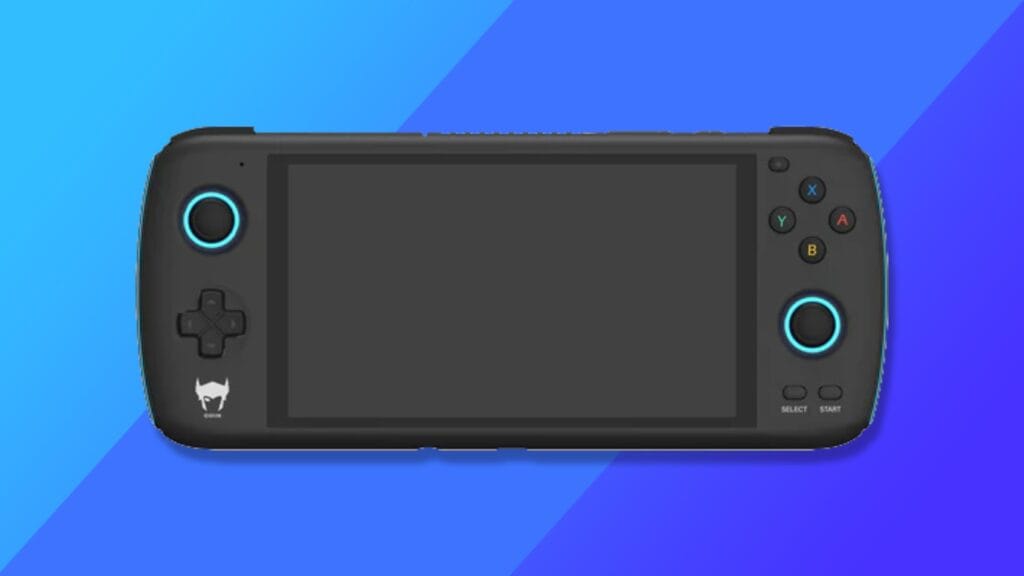
The Ayn Odin Lite and Odin Pro were the ones to beat. Back when the Odin first came out, if you asked me for a recommendation I’d instantly say that because it’s got everything I love.
At $200, it’s one of the cheapest consoles capable of playing up to PS2. And you know how I feel about screens, right? At 5.98-inch in size and a 16:9 ratio, this screen feels like the perfect size. When you hold it, it feels just right. What more could you ask for? Well, quite a lot actually but I’ll get into that in a sec.
Back to emulation, up to PS2 is where the Ayn Odin taps out, and not all PS2 games will run flawlessly, but for a sub-$200 device, that kind of compatibility is unheard of. The likes of the Anbernic RG353P or Retroid Pocket 2 Plus simply can’t compete with that.
So what’s the catch? A fine machine it was but it’s so dated now. Whenever I go to pick up a handheld, I go with the smaller devices like the Retroid Pocket for SNES and Genesis stuff, or the more advanced stuff like the AYANEO Pocket Air for PS2 and beyond. The Odin is old tech on old hardware now, and I prefer to game on either cheaper devices or more powerful ones depending on the game itself.
The other problem with the Odin is the fact shipping times are inconsistent. It could be two weeks, or it could be two months, or it could be much longer. Ayn isn’t able to keep up with demand, which is a good problem for a company to have, but a pain for those looking to purchase the device.
Ayn Odin Lite Specs
- CPU: Mediatek Dimensity D900 | Dual-core A78
- GPU: Mali-G68 MC4
- RAM: 4GB LPDDR4
- Storage: 64GB
- Screen: 5.98-inch IPS LCD dragonglass touchscreen
- Aspect Ratio: 16:9
- Resolution: Up to 1080p at 1080×1920
- Video Output: HDMI
- Connectivity: Wi-fi 6 (a/b/g/n/ac/ax), Bluetooth 5.2
- Operating System: Android 11.0
- Size: 224 by 95 by 15
Ayn Odin Pro Specs
- CPU: Qualcomm Snapdragon SD845 | Quad-core Kyo Gold
- RAM: 8GB LPDDR4
- Storage: 128GB
- Screen: 5.98-inch IPS LCD dragontrail touchscreen
- Aspect Ratio: 16:9
- Resolution: Up to 1080p at 1080×1920
- Video Output: HDMI, display port
- Connectivity: 2.4G, 5G, Wi-fi 802.11 (a/b/g/n/ac/), Bluetooth 5.0
- Operating System: Android 10.0
- Size: 224 by 95 by 15
- Battery: 6000mA
What Can the Ayn Odin Emulate?
- Sega: Genesis/Mega Drive, Master System, Game Gear, SegaCD, Sega32x, Dreamcast
- Nintendo: NES, SNES, Gameboy, Gameboy Advance, DS, some 3DS, N64, GameCube, some Wii, some Wii U
- Sony: PlayStation, some PlayStation 2, PlayStation Portable
- Misc: PC Engine, WonderSwan, Mame, FBNeo, Neo Geo
Valve Steam Deck
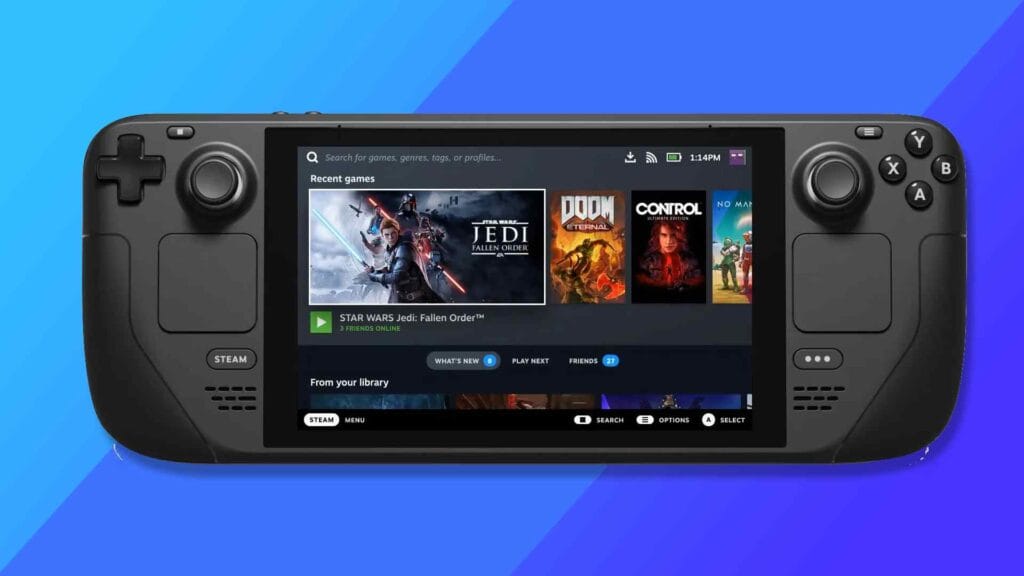
The Steam Deck remains my go-to device for emulation. If it’s pure, raw power you’re after, the Steam Deck is where it’s at.
I’ll never forget the first time I held my Steam Deck. It’s so freaking big! Seriously, nothing prepared me for how chonky it’d be. It definitely ain’t a handheld you’ll fit in a pocket unless you’re wearing MC Hammer pants.
What I found even more wild is despite the massive overall size, it’s surprisingly cool. In my head, I expected a bunch of high-end PC tech inside of a small confined space to be quite hot, but the cooling system keeps things, well, cool. I did notice the back-right of the case seems to get much hotter than the back-left side, though.
In terms of what it can emulate, what it can’t emulate is most likely easier to run through. I’ve been able to play everything I threw at it up to PS3. Xbox 360 I spent far too long getting the Xenia emulator working only to find out it’s awful. Same for PS3. Switch I had some success with, but it’s not good enough to recommend for that just yet.
The biggest shocker, for me at least, was Zelda: Breath of the Wild. I got the Wii U version running at a mostly smooth 45 frames per second, which I really was not expecting. Wild, right?
Also, and this is the smallest thing ever, but I can’t get over how nice the back buttons feel. They actually sit where your fingers rest.
For PC gaming, I was up and running in about five minutes, which is very fast. If you’ve got a Steam account, integration is simple and the operating system is surprisingly nice once you adapt to it. You are free to chuck Windows onto the device if you want to, though, but you shouldn’t because the fan sounds like it’s going to explode. Stick with SteamOS.
Going back to the AYN Odin comparison, the biggest issue here is shipping times. Buying a Steam Deck has been simplified, but you’re still going to be waiting a good couple of weeks for it to arrive. Mine took that long and the tracking rarely updated until it was practically outside my house ready to be delivered.
The Steam Deck isn’t exactly affordable, but neither is it overly expensive. For what you’re getting in terms of power, there’s definitely value there.
Steam Deck Specs
- Processor: AMD APU
- CPU: Zen 2 4c/8t, 2.4-3.5GHz (up to 448 gigaFLOPS FP32)
- GPU: 8 RDNA 2 CUs, 1.0-1.6GHz (up to 1.6 teraFLOPS FP32)
- RAM: 16 GB LPDDR5 onboard RAM (5500 MT/s quad 32-bit channels)
- Storage Options: 64 GB eMMC/256 GB NVMe SSD/512 GB high-speed NVMe SSD
- Display: 1280 x 800 pixels (16:9)
-
Type: Optically bonded IPS LCD for enhanced readability
-
Screen size: Seven-inches
-
Refresh rate: 60Hz
-
Touchscreen: Yes
What Can the Steam Deck Emulate?
- Sega: Genesis/Mega Drive, Master System, Game Gear, SegaCD, Sega32x, Dreamcast
- Nintendo: NES, SNES, Gameboy, Gameboy Advance, DS, 3DS, N64, GameCube, Wii, Wii U, Nintendo Switch
- Sony: PlayStation, PlayStation 2, PlayStation Portable, PlayStation 3
- Microsoft: Xbox, Xbox 360, Xbox Game Streaming
- Misc: PC Engine, WonderSwan, Mame, FBNeo, Neo Geo
Anbernic RG353P
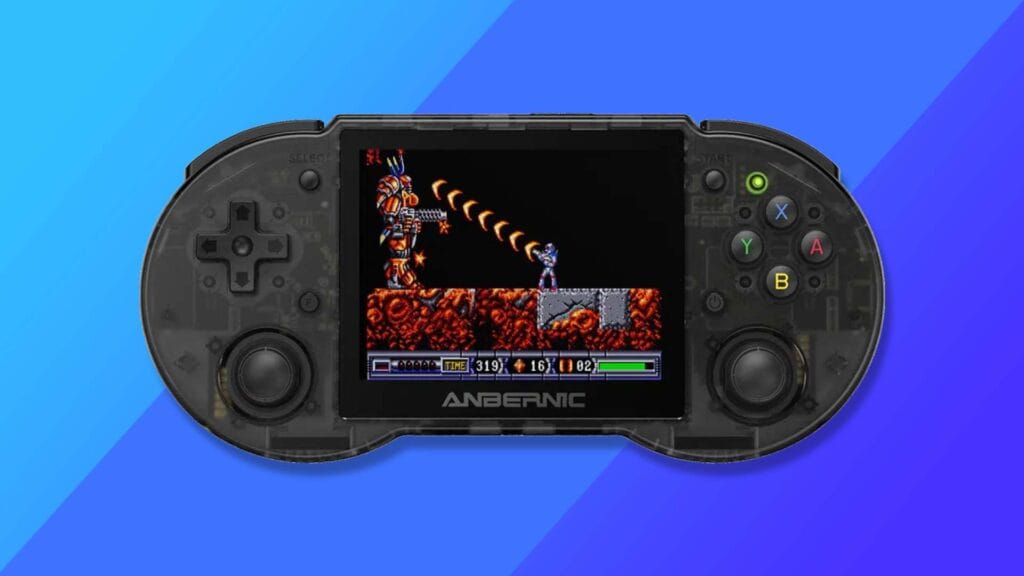
The Anbernic RG353 is how upgrades should be done. While it is a price increase over the RG351P, the extra power here lets owners play up to Dreamcast.
Up to Dreamcast is where the RG353P hits its limit and it’s worth mentioning Dreamcast and N64 performance isn’t perfect. Some games will run with few issues, but the harder-to-emulate titles will perform worse.
This isn’t really a deal-breaker, though. The RG353P still falls into the affordable price category, and given it’s a clear upgrade over the RG351P, the extra RAM and faster chipset are pleasant surprises, even if coverage for the newer systems isn’t 100 percent.
It’s the rounded design of the RG353P that really sells it as well. So many of the handhelds I’ve bought feature right-angle corners and they’re so uncomfortable to hold. Whenever I play on my RG353P, I never get hand cramps during long sessions, and that’s thanks to those rounded grips. They fit in my hand and feel natural.
If you’ve got any minor motor issues and want something that fits snugly, I’d definitely recommend the RG353P for the comfort factor alone.
Anbernic RG353P Specs
- Chipset: RK3566 – Quad-core 64-bit Cortex-A55 at 1.8GHz
- RAM: 2GB LPDDR4x
- Storage: 32GB eMMC, 16GB microSD card
- Connectivity: 2.4/5G, Bluetooth, HMDI-out
- Screen: 3.5-inch IPS with OCA full-tilt, 640×480
- Battery: Li-polymer 3500 mAH (around six hours)
What Can the RG353P Emulate?
- Sega: Genesis/Mega Drive, Master System, Game Gear, SegaCD, Sega32x, Dreamcast
- Nintendo: NES, SNES, Gameboy, Gameboy Advance, DS, N64
- Sony: PlayStation
- Misc: PC Engine, WonderSwan, Mame, FBNeo, Neo Geo
Miyoo Mini

As someone who loved the original Game Boy, I pretty much knew I’d love the Miyoo Mini.
The Miyoo Mini came out of nowhere and became a smash hit with retro enthusiasts. It’s one of the smallest consoles out there and that form factor resonated with owners, myself included.
In terms of power, the Miyoo Mini is the weakest on this guide by a clear mile. That’s okay, though, because the Miyoo Mini is more of a novelty console. It’s all about the aesthetic rather than playing retro games with modern options like resolution or speed boosts.
I was able to get SNES, Genesis, and Game Boy Advance games running without too many problems, so I’d consider that a win.
Screen quality is fine and emulation performance overall is passable. The systems it can emulate will work, just don’t expect anything groundbreaking. I’d also advise avoiding PS1 altogether. It kind of works, but I didn’t like the lack of buttons on mine.
Still, if you’re after something that’s pure nostalgia, the Miyoo Mini’s low cost makes it easy to recommend as a display console. Just remember if you’re serious about gaming on the go, the Anbernic and Retroid offerings are better choices in the long run.
Miyoo Mini Specs
- Screen Size: 2.8-inch IPS screen
- Resolution: 640×480
- Operating System: Linux
- CPU: ARM Cortex-A7 dual-core 1.2Ghz
- RAM: 128MB
- Size: 93.5mm by 65mm by 18mm
- Battery: 2000mAH (around three to four hours)
- Charging: USB-C
What Can the Miyoo Mini Emulate?
- Sega: Mega Drive/Genesis, Master System, Game Gear
- Nintendo: GBA, GBC,GB, SFC, FC,
- Sony: PS1
- Misc: PC Engine, WonderSwan, Mame, FBNeo, Neo Geo
AOKZOE A1 Handheld
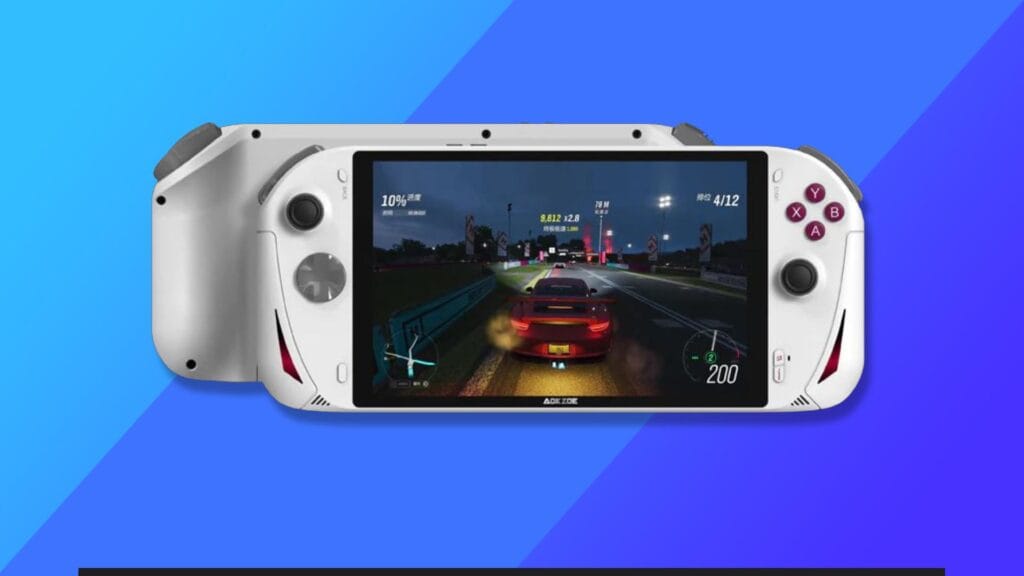
The AOKZOE A1 is a Windows-based handheld. That means along with being able to emulate a massive amount of consoles, you’ve also got something powerful enough to run AAA PC games like Elden Ring and Cyberpunk 2077.
One of my problems with the Steam Deck is that despite being Windows-literate, I had to relearn the Linux operating system. With the AOKZOE, because I knew how Windows works, I was able to dive right in without any fuss.
One thing I’ll give the AOKZOE A1 is the console’s design. Normally with Windows handhelds companies have a tendency to just smash everything together and hope for the best. The AOKZOE A1 doesn’t fall into that trap, though. It’s a handheld that looks designed to be played by humans and I could tell the difference the first time I held one. Comfort and ease of use are at the forefront of the design.
The biggest drawback here is going to be the price. It costs more than the Steam Deck, and with prices starting at $1099/£925 for the base model, it’s simply going to be too expensive for many.
Still, if you’re after power and money isn’t an issue, the AOKZOE A1 is one of the best retro handhelds to keep an eye on.
AOKZOE A1 Specs
- CPU: AMD Ryzen 7 6800U
- GPU: Radeon 680M
- RAM: 16GB/32GB
- Storage: 512GB/1TB /2TB
- Screen: Eight-inch IPS display, sRGB
- Operating System: Windows 11, Steam OS
- Misc: RGB, Lighting, PD charge, gyroscope
What Can the AOKZOE A1 Emulate?
- Sega: Genesis/Mega Drive, Master System, Game Gear, SegaCD, Sega32x, Dreamcast
- Nintendo: NES, SNES, Gameboy, Gameboy Advance, DS, 3DS, N64, GameCube, Wii, Wii U, Nintendo Switch
- Sony: PlayStation, PlayStation 2, PlayStation Portable, PlayStation 3
- Microsoft: Xbox, Xbox 360, Xbox Game Streaming
- Misc: PC Engine, WonderSwan, Mame, FBNeo, Neo Geo
GPD Win Max 2
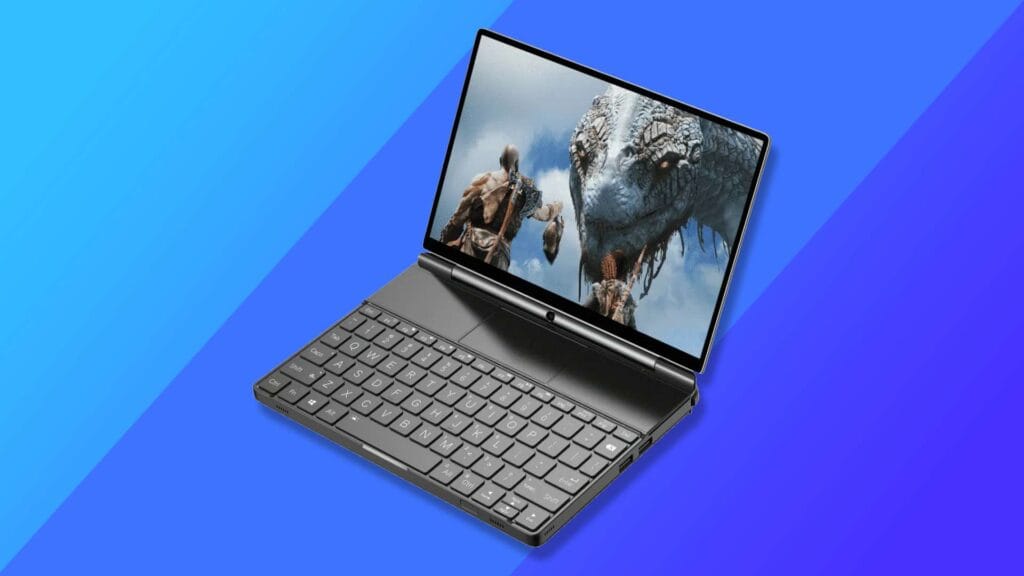
Companies tend to play it safe. Horizontal consoles rule the retro gaming space because they’re tried and tested. But GPD isn’t one to play it safe. The company has made a name for itself by taking risks.
Do the risks always pay off? Not always, no. They wouldn’t be risks if they always worked. But when the risk does pay off, you get something utterly unique, as is the case with the GPD Win Max 2.
Here is one of the best retro handhelds that doubles as a laptop. Having a Windows device with a dedicated keyboard is going to make using the device that much easier. And while the layout of the sticks may be somewhat awkward, they work surprisingly well once you’ve adjusted.
In terms of power, the Win Max 2 has enough to emulate up to PS3, though that will vary depending on which version of the console picked up.
As with the AOKZOE A1, price is the biggest barrier here. The specs and the design make the pricing justifiable, but there’s no getting around it’s still a lot.
The power here also makes this a device capable of playing the latest AAA games. God of War runs at around 45 frames per second, Elden Ring at a little over 30, and Halo Infinite at 50 – all of those will need to be on low to get the best performance.
The question to ask yourself here is do you want to drop the pocket portability in favor of something that’s a halfway house between a handheld and laptop? And whether you want to drop big money on it, too.
GPD Win Max 2 Specs
- CPU: Intel Core i7-1260P/ AMD Ryzen 7 6800U
- GPU: Intel Iris Xe Graphics 96EU/AMD Radeon 680M
- RAM: 16GB LPDDR5/32GB LPDDR5s
- Storage: Up to 2TB High-Speed PCI-E NVMe SSD
- Screen: 10.1-inch touchscreen
- Connectivity: Wi-Fi 6, Bluetooth: 5.2, Thunderbolt 4 (USB4)
- Battery: 67Wh
What Can the GPD Win Max 2 Emulate?
- Sega: Genesis/Mega Drive, Master System, Game Gear, SegaCD, Sega32x, Dreamcast
- Nintendo: NES, SNES, Gameboy, Gameboy Advance, DS, 3DS, N64, GameCube, Wii, Wii U, Nintendo Switch
- Sony: PlayStation, PlayStation 2, PlayStation Portable, PlayStation 3
- Microsoft: Xbox, Xbox 360
- Misc: PC Engine, WonderSwan, Mame, FBNeo, Neo Geo
Retroid Pocket 2 Plus
 Even though the Retroid Pocket 3 is now out, the Retroid Pocket 2 Plus is still a powerful, Android-based console that ticks all the boxes.
Even though the Retroid Pocket 3 is now out, the Retroid Pocket 2 Plus is still a powerful, Android-based console that ticks all the boxes.
Whereas Anbernic consoles use power to brute force their way through emulation, the Retroid Pocket 2 impresses because of how smart everything has been implemented.
In terms of power, it’s in the same ballpark as the RG351P, but that isn’t the whole story. Through clever engineering, the Retroid Pocket 2 is one of the best handheld emulator consoles due to its ability to punch above what it should be capable of.
It’s not a GameCube player by any means, but then it’s capable of playing the lighter GameCube games like Luigi’s Mansion with minimal issues. How the team at Retroid somehow achieved this is enough to make your head explode. It shouldn’t be possible, but through clever coding, it is.
The big change here compared with the Anbernic devices is the switch to Android. Linux is a great operating system when used correctly, but Android offers up access to the Google Play store, which in turn grants access to a larger supply of different emulator apps, including the brilliant PS1 emulator ePSXe on Android.
It’s a little more expensive than the basic Anbernic devices, but given the power increase and aforementioned switch to Android, the price difference makes sense and is justified.
Retroid Pocket 2 Plus Specs
- Chipset: Unisoc Quad-core Tiger T310
- RAM: 2GB LPDDR4
- Storage: 32GB eMMc
- Android 9
- Connectivity: Wi-Fi 2.4G and 5G, Bluetooth 5
- Battery 4000mAh
- Screen Size: 3.5-inch touchscreen
- Resolution: 480p
What Can the Retroid Pocket 2 Plus Emulate?
- Sega: Genesis/Mega Drive, Master System, Game Gear, SegaCD, Sega32x
- Nintendo: NES, SNES, Gameboy, Gameboy Advance, DS, some N64, some GameCube
- Sony: PlayStation
- Misc: PC Engine, WonderSwan, Mame, FBNeo, Neo Geo
Powkiddy RGB10 Max 2
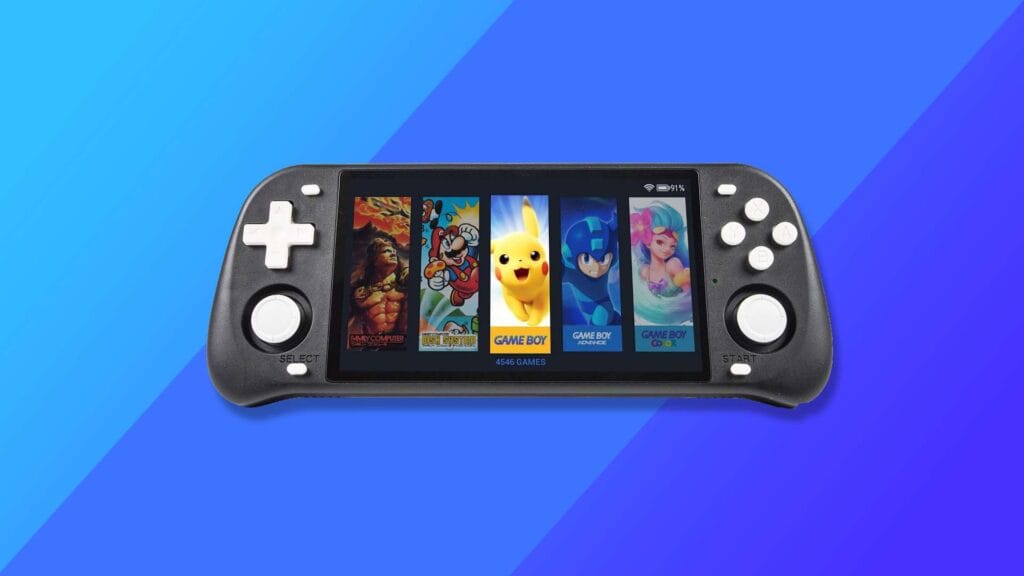
The Powkiddy RGB10 Max 2 often gets forgotten about when it comes to retro handheld guides and that’s a real shame. Sure, it looks like a toy, but that just makes it all the more endearing.
On the power front, the Powkiddy RGB 10 Max 2 matches the Anbernic RG351P. So that’s up to PS1 emulation without any issues.
It’s where things differ that the RGB 10 Max 2 comes to life. For a start, you’ve got a larger screen, and thanks to a user-friendly operating system everything looks great on this device.
Not only that, rounded grips on the back of the Powkiddy RGB 10 Max 2 really make this thing feel comfortable. The grips fit snuggly into the hand, meaning you can play this thing for hours without your hands cramping up.
RetroDodo also makes a really great point about the smaller bezels. The screen really is at the forefront of the design and Powkiddy has done all it can to avoid wasted space.
Granted the RK3326 chipset is overused now, but if you’re after quality visuals and aren’t fussed about playing anything above PS1, the Powkiddy RGB 10 Max 2 comes easy to recommend.
Powkiddy RGB10 Max 2 Specs
- Chipset: RK3326
- RAM: 1GB DDR3L
- Screen: five-inch IPS OCA screen (854×480)
- Connectivity: Wi-Fi, Bluetooth
- Storage: 64GB with microSD support
- Operating System: Linux
- Battery: Li-polymer 4200mAh
What Can the Powkiddy RGB10 Max 2 Emulate?
- Sega: Genesis/Mega Drive, Master System, Game Gear, SegaCD, Sega32x
- Nintendo: NES, SNES, Gameboy, Gameboy Advance
- Sony: PlayStation
- Misc: PC Engine, WonderSwan, Mame, FBNeo, Neo Geo
Evercade Exp
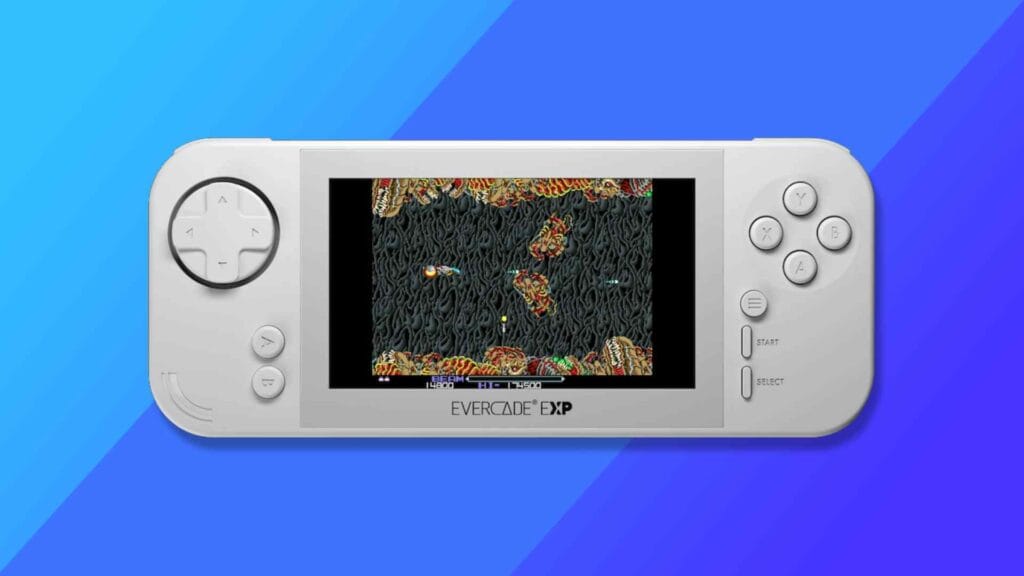
Here’s where things take a different turn. The Evercade Exp isn’t an emulator console. Instead, it’s more comparable with a Game Boy Advance than an RG351P.
With the Evercade Exp, you buy cartridges that house several games. Think of them as collections. So far there’s everything from Worms to Sensible Soccer. Although there are no Nintendo or Sega games in sight, Evercade focuses on the lesser-known but still beloved titles you can’t play unless you own the original hardware.
That’s what makes the Evercade Exp such a special device. It’s one for collectors and offers up a completely legal avenue for those who want to actually own the games they play.
Evercade Exp Specs
- CPU: 1.5Ghz Processor
- RAM: 4GB
- Screen: 4.3-inch IPS display -800×480
- Charging: USB-C
- Output: 720p via mini-HDMI
- Battery: 3000mA – around four to five hours
What Can the Evercade Exp Emulate?
- Nothing, games come in cartridge form
Anbernic RG351
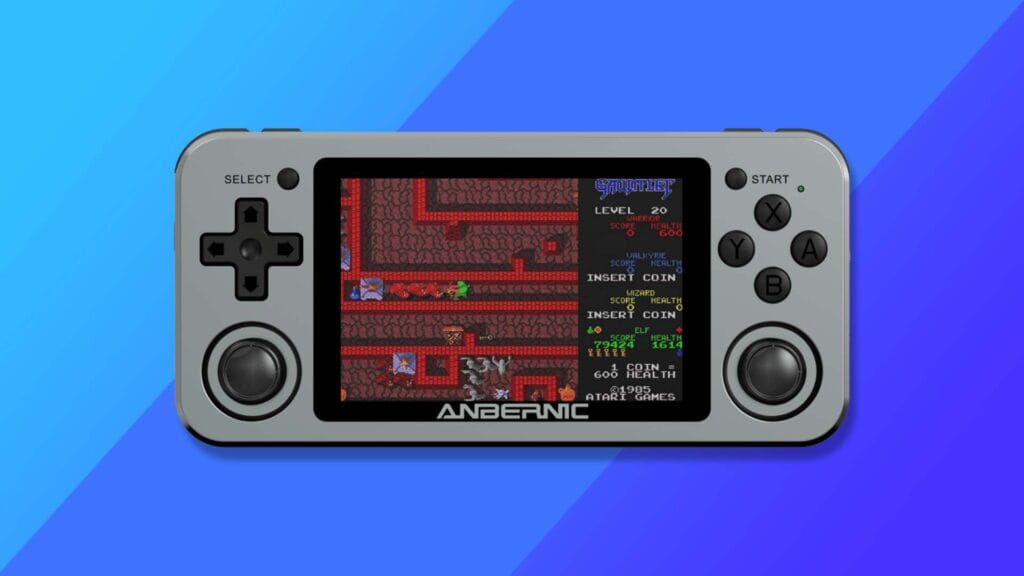
The Anbernic RG351P is one of the go-to consoles for many. It exists at a comparatively low price point and offers up stellar emulation.
If your main goal is to play Sega and Nintendo games on a device that fits in your pocket, the RG351P is perfect for that. Emulation speeds very rarely falter, resulting in clean gameplay that feels like the original hardware. Just keep in mind the specs here do limit what it’s capable of compared with the higher-end devices like the Ayn Odin. Up to PS1 is where this console hits its limits.
It’s also worth mentioning the RK3326 chipset is both over-used and fairly dated now. It does what it needs to and it does that well, but in terms of what else is available, it’s now falling into the lower end when it comes to power.
The RG353P, for example, uses a more recent chipset, and the speed difference is noticeable, although the RG353P does cost more as well. So if affordability is what matters, the RG351P is still going to come out on top.
Something else to consider, you can get the previous model the RG350 for cheaper than the RG351P but there are some drawbacks, mostly in the form of the operating system.
Both devices use the same chipset, but the RG351P features upgrades to the system to make it more intuitive and generally look nicer. The RG351P also boasts an ARM processor meaning it can run indie games that have been ported to the console. Neat!
If you can afford the difference, the RG351P is one of the best emulator consoles out there. It’s simply not worth going for the cheaper model that’s inferior in almost every way.
RG351P Specs
- Chipset: RK3326
- GPU: Mali-G31 MP
- RAM: 1GB
- Screen: 3.5-inch IPS at 320 by 480 resolution
- Operating System: Linux
- Battery: 3500 mAH
What Can the RG351P Emulate?
- Sega: Genesis/Mega Drive, Master System, Game Gear, SegaCD, Sega32x
- Nintendo: NES, SNES, Gameboy, Gameboy Advance
- Sony: PlayStation
- Misc: PC Engine, WonderSwan, Mame, FBNeo, Neo Geo
A Note About Battery Life
One thing any prospective buyers need to factor in is battery life. On lower-end consoles like the RG353P or Retroid Pocket 2 Plus, battery life is solid, and you can pull around four to six hours on average.
But with more power comes a massive hit to battery life, especially when it comes to running the latest AAA games and emulating the more powerful consoles.
This isn’t a problem any company has solved yet, and while the Steam Deck may offer better battery life than the AYANEO Air, neither consoles offer up what would be considered as good.
They are portable, but chances are you’re going to spend a lot of your time plugged in. It’s not a problem if you’re at home and need a second screen to game on, but if you’re looking at any of the high-end consoles as something for a commute, they won’t last.
On average, battery life for AAA-capable consoles range anywhere from 45 minutes to a couple of hours. You can alter settings to get more out of it, but it’s worth factoring that battery life is, generally, abysmal across the board.
If you are after something for outside gaming, definitely consider going with the cheaper, smaller retro devices. That four to six hours of usage is exactly where it should be.

